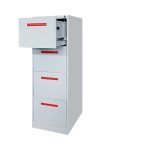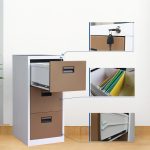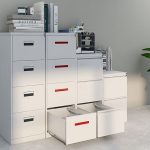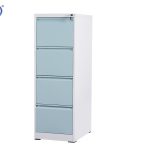Metal drawer cabinets are one of the most common furniture in offices, homes, and commercial places. They are widely used for their convenient storage functions. However, over time, metal drawer cabinets may also have some faults, affecting their user experience. Understanding common fault types and solutions can help extend the life of the drawer cabinet and ensure its normal operation.
Common Problem Types & Causes
a. Cabinet Door & Drawer Issues
Symptoms: Doors jammed or failing to close tightly; Drawers sticking or derailing during use.
Root Causes:
- Clogged tracks: Dust, hair, or debris accumulation.
- Structural warping: Overloading or humidity fluctuations (common in wooden cabinets).
- Lubrication failure: Dried-out grease or misuse of petroleum-based oils (causing track hardening).
b. Lock System Failures
Typical Issues: Broken keys, stuck lock cores; Electronic lock malfunctions (common in smart cabinets).
Key Causes: Mechanical locks: Misaligned bolts; Electronic locks: Oxidized contacts.
c. Structural Instability
Signs: Cabinet wobbling or uneven gaps between doors; Stuck casters or uneven leveling.
Primary Factors: Floor unevenness; Loose connectors.
Step-by-Step Troubleshooting
a. Fixing Jammed Doors
Tools: Hex key (4mm), silicone lubricant, vacuum cleaner.
Steps:
① Remove the door and vacuum debris from track blind spots (focus on 10cm zones at track ends).
② Apply silicone lubricant (avoid WD-40 to prevent plastic corrosion).
③ Adjust hinges: Turn screws clockwise by ¼ rotation to improve closure precision by 0.5mm.
b. Smoothing Sticky Drawers
Diagnosis:
Empty-drawer test: If smooth → Overloading issue (reduce load to 70% of capacity).
Loaded-drawer issue → Check ball bearings (replace if >3 are missing).
Toolkit:
Nylon pry bar (for safe track removal without scratches).
Replacement slides (60kg capacity, TUV-certified).
c. Lock Repair Guide
Mechanical Locks:
Spray graphite powder into the keyhole (40% better dust resistance vs. liquid lubricants).
For misaligned bolts, gently tap the cabinet side with a rubber mallet (force ≤5N).
Electronic Locks:
Clean contacts with alcohol wipes (quarterly).
Check backup batteries (replace if voltage <3V).
d. Stabilizing Wobbly Cabinets
Tools: Laser level, anti-slip shims (1-5mm thickness).
Procedure:
① Measure tilt with a leveling app (e.g., Bubble Level, ±0.1° accuracy).
② Insert rubber shims under low-side feet (1mm shim corrects 2° tilt).
③ Tighten all screws to 1.5-2N·m torque (use a torque wrench).
Material-Specific Fault Prevention
| Material | Common Issues | Tailored Solutions |
| Steel Cabinets | Rust, static-attracted dust | Apply anti-rust wax quarterly; ensure grounding. |
| Wooden Cabinets | Swelling, cracked finishes | Maintain 45-65% humidity; refinish with beeswax. |
| Stainless Steel | Visible scratches, weld rust | Polish monthly with oxalic acid; avoid chlorine exposure. |
| Cold-Rolled Steel | Peeling paint, sharp edges | Repaint via electrostatic spray; add edge guards. |
Preventive Maintenance Schedule
a. Daily Checks
Verify drawer loads; Monitor electronic lock battery indicators.
b. Monthly Tasks
Scrub grooves with isopropyl alcohol (70%) and cotton swabs.
Remove stubborn grime using melamine sponges (avoid steel wool).
Lubrication:
High-temperature environments → PTFE dry-film lubricant (250°C resistant).
Low-temperature environments → Silicone grease (remains fluid at -50°C).
c. Annual Maintenance
Structural Reinforcement: Retighten all fasteners; Reapply wood wax.
Safety Tests:
Tilt resistance ≥50kg (test with a pull gauge); Slide endurance 50 smooth open/close cycles required.
Conclusion
Understanding common problems and solutions, and taking timely action, can ensure that your metal drawer cabinets always remain in good working condition. Whether it is a chest of drawers made of metal, wood, or stainless steel, reasonable daily maintenance and preventive measures are essential.





